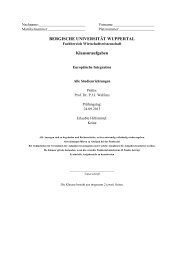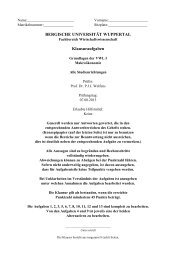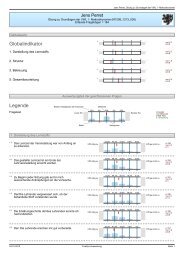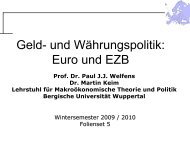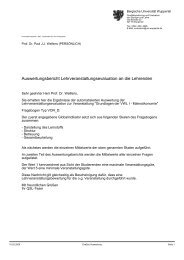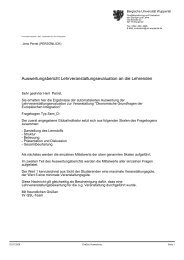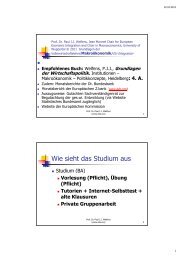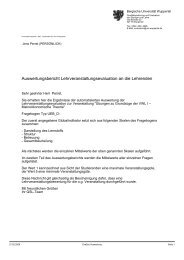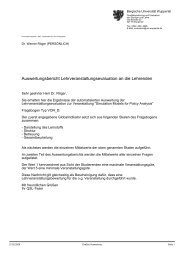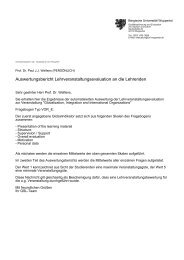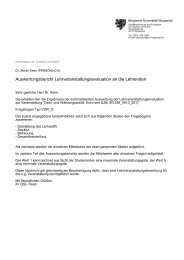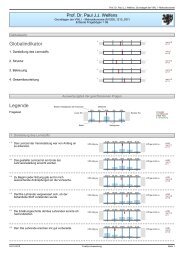UNIVERSITÄT POTSDAM - Prof. Dr. Paul JJ Welfens
UNIVERSITÄT POTSDAM - Prof. Dr. Paul JJ Welfens
UNIVERSITÄT POTSDAM - Prof. Dr. Paul JJ Welfens
Create successful ePaper yourself
Turn your PDF publications into a flip-book with our unique Google optimized e-Paper software.
Tab 6: The Growth Contributions of IT and Non-IT Capital, Labor and Total<br />
Factor Productivity, 1991-99<br />
(1) (2) (3) (4) (5)<br />
GDP IT CAPITAL NON-IT<br />
CAPITAL<br />
Labor TFP<br />
USA 3.34 0.94 0.42 0.90 1.08<br />
Ireland 6.91 0.64 0.63 1.93 3.72<br />
Denmark 2.87 0.52 0.60 0.34 1.40<br />
Netherlands 2.83 0.68 0.31 1.09 0.75<br />
UK 2.68 0.76 0.37 0.51 1.04<br />
Portugal 2.47 0.43 1.05 -0.35 1.34<br />
Austria 2.33 0.45 1.29 -0.46 1.04<br />
Spain 2.32 0.36 1.10 0.36 0.51<br />
Greece 2.25 0.34 0.65 0.46 0.78<br />
Finland 2.13 0.45 -0.13 -1.05 2.86<br />
Belgium 1.88 0.48 0.68 0.00 0.72<br />
Sweden 1.86 0.59 0.32 -0.28 1.23<br />
Germany* 1.65 0.49 0.56 -0.23 0.83<br />
France 1.64 0.41 0.49 -0.19 0.92<br />
Italy 1.41 0.31 0.82 -0.30 0.58<br />
Notes: Data in percentage points. Column (1) presents GDP (business sector, measured at factor costs)<br />
growth rates from 1991-99. Column (2)-(5) present the contributions of employment (hours worked), IT<br />
and non-IT capital and total factor productivity to GDP growth.<br />
* Germany = 1992-1999<br />
Source: DAVERI, F. (2001): Information Technology and Growth in Europe, p. 7.<br />
While the US recorded an acceleration in growth contribution from IT capital, namely<br />
from 0.53 in 1991-95 to 1.45 in 1996-99, Germany had a rather flat contribution from<br />
IT capital, namely 0.5. Insufficient structural change, the monopoly of telecommunications<br />
until 1998, and lack of cheap internet rates (including the refusal of Deutsche<br />
Telekom AG (except for the second half of 2000) to offer a flat rate for standard telecommunications<br />
users could be main elements in explaining the modest IT contribution<br />
in Germany (WELFENS, 2001b, 2001c; WELFENS / JUNGMITTAG, 2001). Comparing<br />
the US and the EU it is quite obvious that computer density in the Community is<br />
much lower than in the US. Germany reached three-fourths of the US computer density;<br />
France was slightly weaker, and Italy, with about one-half of US computer density,<br />
was just at the level of Korea in 1999. In the EU only the Scandinavian countries<br />
had a computer density comparable to the US. It is noteworthy that Sweden’s tax policy<br />
contributed actively to raising computer density by giving firms tax incentives to<br />
sell used PCs at discount prices to employees.<br />
17



